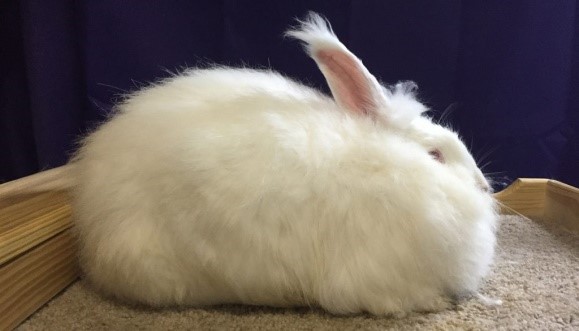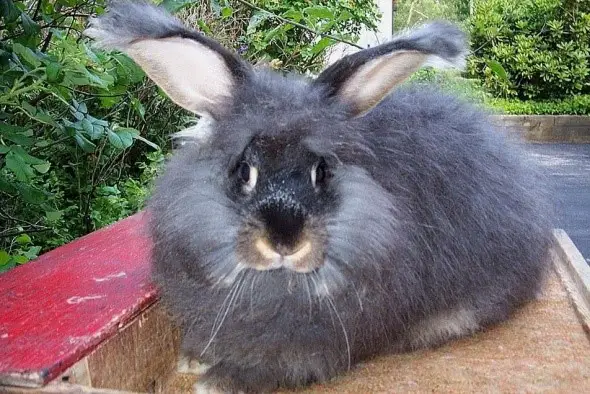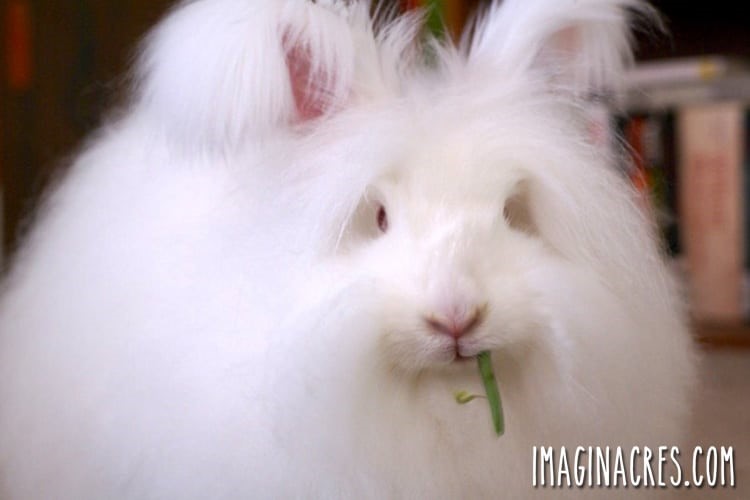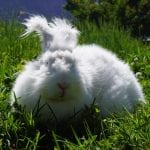Scientific Facts
| Common Name | Giant Angora |
| Scientific Name | Cryctlagus Cuniculus |
| Life Span | 5-8 years |
| Size (Adult) | Giant/large |
| Weight (Adult) | 9 to 12 pounds |
| Body Shape | Commercial type |
| Habitat | Normal size wire cages |
| Country of Origin | Ankara, Turkey |
Physical Description

The Giant Angora Rabbit is known to be the largest of all the domestic breeds of Angora Rabbit. This is a 6-class breed of rabbits that is believed to the showiest of all rabbits. This also boasts a huge-sized oval head and a commercial type of body. Its head is quite narrower right through the muzzle. It has facial forehead tufts, including cheek furnishings. Even its ears are well-tasseled and lightly-fringed.
This rabbit is recognized for producing the most wool. This has three various kinds of fiber found in its wool: awn fluff, awn hair, and soft underwool. So that its wool is kept mat-free, brushing it using a bristled brush once a day is necessary. If ever the wool gets quite dirty, clean it using a damp towel.
Fast Facts
Here are some of the fast facts about the Giant Angora rabbit.:
Best Suited For: Families with older kids, experienced pet owners as outdoor rabbits or house rabbits
Temperament: Love to Run, Very Social
Comparable Breeds: Flemish Giant Rabbit, and German Angora Rabbit
Colors

Just the same with all other Angora rabbits, the Giant Angora rabbit comes in many different hues from brown to black and grey. Some come in broken colors. The ARBA only accepts the color of ruby-eyed white rabbits or the REW. They also are called as the albino rabbits.
Lifestyle and Behavior
Just as the Giant Angora is a gentle and docile rabbit, it’s when you, as the owner, should give it a chance to interact with people. It must also spend time away from its enclosure. This is the only way that it could best show its personality.
It comes in a huge size, which is why it is not suited for kids who have no idea how to hold the pet. The rabbit might get injured, or the opposite can happen. Train older kids on how to best handle the bunnies.
Pour your patience and love towards the rabbit. Train it to use the little boxes. Position the litter box in a strategic way possible to best avoid the droppings all around the house.
When this rabbit is kept inside the enclosure and away from the activity of humans, it won’t create a good and lasting relationship. So if you decide to keep it indoors or outdoors, make sure that enough room is provided for it. This will enable it to roam around safely and freely.
As for an indoor rabbit, it must enjoy the freedom of hopping around the round and accessing the sunlight. The outdoor rabbit must also stay outside the enclosure for several hours every day. This is for it to do the stretching of its legs in the fenced yard.
This breed of rabbit is recommended for those people living in their apartments. Families or couples should prepare for a fenced yard for it. Toys should also be given to keep it entertained.
Habitat
Since you will take good care of the Giant Angora, you need to keep in mind the location of the cage. This pet can be housed inside and outside that depends on the residential property.
For an outdoor cage, protect it against the weather. Locate it in a shady area covered with a full roof, rear walls, and sidewalls. If you live in a windy or wet area, you need to cover the front up of blowing snow or rain.
While the rabbit can handle cold better than heat, rain-free and draft are still necessary. Raise the cage 2 to 3 feet off the ground. This will allow easy and convenient cleaning while offering protection.
Place the cage in a secured area. Never estimate how fast a wild animal or dog can enter through a cage. Other animals might kill your rabbits, too. One more line of defense is the fenced yard. A cage placed next to the house is also a good idea. If you place it far away, it might become difficult to care for it.
The cage for the Giant Angora should be situated in a draft-free area. It should be away from other hazards and the windows. There should be no dangerous items and no cords within reach. This breed of rabbit can do a lot better in the main area than a little-used area or a spare bedroom.
Eating Habits

Giant angora demands a diet that is rich in fiber and protein. Extra protein also needs to be added for wool production. The high amount of fiber reduces the risk of getting the wool block. Better to buy commercial pellets that contain eighteen percent protein. Buy this online that will then be delivered to your home.
Feed the rabbit too with organic feeds that can be ordered at the local feed store. Until the age of four and six months, the rabbit can be fed with pellets, hay, and timothy grass. But never feed it with extra alfalfa. This is rich in calcium that may increase the chance of urinary problems like bladder stones and sludge. Past 6 months, its food intake now needs to be reduced.
Food bowl choices in many sizes are also perfect for the Giant Angora. Metal sifter feeders also can be useful when attached to the inside or outside of the cage. They can prevent the rabbit from getting their feed. They just need to be placed high enough so that they do not take away the floor space for the rabbit. The food bowl somehow needs to be cleaned with water and soap once a week.
Grooming
Giant angora grooming tools consist of a small-tooth comb and grooming brush for combing out the facial mats. Harvest the wool with the use of a double-sided comb. Get at any mats forming next to the skin. Make use of a pair of scissors to cut out the mats and pet nail trimmers for the nails.
Also, choose a blower that is great when blowing out loose hair, dry skin, and other debris. Gently brush the Giant Angora rabbit once or twice a week. It is with regular grooming that can keep its coat free from mats. It helps reduce the risk of producing loose hair and wool block.
Maintain the length and density of the wool coat as well. Follow some special grooming techniques that include the use of a blower. Groom your rabbit regularly so that it is kept free from tangles and mats.
Spraying or Neutering
Neutering and spraying the bucks is suggested when you’re not after breeding the Giant Angora. What is more likely to develop nasty male habits are the intact bucks. They would often spray urine. The female Giant Angora is highly susceptible to uterine and ovarian cancers that can be avoided by spraying. That is when their lives are extended, as well.
Neutered bucks are always considered as the best pets. They also experience hormonal fluctuations making them less cuddly and moody at times. First-time owners are advised to getting a buck that will accept the love you give them.
Temperament and Personality
Consider the Giant Angora, a gentle and docile rabbit. It must be allowed to spend time away from its enclosure. It’s when it can show its personality and engage with people. But since, as mentioned above, it comes in huge size, it is not suited for people having kids. This is true if these kids do not know about handling big pets. They will only get themselves injured, or the opposite. As a pet owner, train older kids on how to best handle these bunnies.
Lifespan and Health Concerns
So that the Giant Angora can reach its life span of 5 to 8 years, try to get focused on its health. Worry about the risk of it developing the wool block. This rabbit is a clean creature the same as other animals. It also enjoys grooming itself in keeping the coat in good condition. While a cat regurgitates its fur that is swallowed by accident, rabbit, on the other hand, doesn’t.
Its diet that is not enriched in hay gets the wool stuck in the stomachs, That eventually results in a hairball. It then believes that its bellies are full, leaving it refusing the foods to eat. It eventually dies because of starvation. The symptoms of wool block include fewer droppings, lack of appetite, and less activity. When you suspect the rabbit experiences wool block, rush it to the local vet to get the problem sorted.
What more, the Giant Angora is susceptible to developing overgrown teeth. This may be the result of a diet lacking in a proper balance of hay. This is used to grind their teeth down naturally. Such overgrowth of teeth reaches into the jaw and face of the rabbit, which can be very painful. Check the mouth of the rabbit once in a while. Make sure that it be presented a proper diet of hay.
Health Care
Part of health care tips is to ensure the rabbit not end up with the wool blocks. If it always ingests the coat, it can be risky that it blocks the digestive tract. This only will leave the rabbit feeling full while it refuses to eat. It only will have smaller and fewer dropping causing its death. Talk to the veterinarian when there is a wool block.
Check for fleas, mites, and flystrike. De-worm the bunnies twice every year. Never forget it checking ill-health symptoms like loss of appetite, loss of fur, watery eyes, coughing, runny nose, high fever, and many more.
Special Care Considerations
Consider the thick wool of the Giant Angora. It is vulnerable when exposed to changes in temperature. This is true after a month of shaving, and as the temperatures go high.
While the nails need to be trimmed regularly. When the nails are not trimmed regularly, they may grow too long and may get caught on the floor. The possibility of the long nails broken and ripped off is also too high. So never neglect the task of trimming it. The longer that the nails become, the harder it be to manage the nails at a safer and manageable length.
Breeding
Weighing in 9 and a half to 10 pounds, the Giant Angora is by far the biggest of the angora breeds. This is also one of the highest producers of fiber in the group. Giant Angora can be the result of breeding the Flemish giant and the German angora.
Normally it takes a bit of planning and preparation before the breeding occurs. There must be enough time and space. The doe could give birth to 2 or 3 or even 15. Once those babies reach four or five months old, each will have their own home or cage. Groom them as young as two months. If you have time for that, then breed.
Breeders National Federation
The American Breeders Association or (ARBA) is a federation group that recognizes a wide range of rabbit breeds such as the Giant Angora. They believe that this rabbit is bigger and is better. As you go check out other breeds, you will realize how it makes an excellent pet. It is known for its docile nature and is popular for its charm.
The National Angora Rabbit Breeders Club is also another known body of the organization. The breed reaches at least 9 and 1/2 pounds for the senior bucks and also 10 pounds for the senior does. This animal is indeed gorgeous, and show-stopping is having its pink eyes and white fur. The wool only needs to be removed by combing or sheers.
Cost
The price of the Giant Angora varies but be ready to spend anything from 50 dollars to 300 dollars. As for the pedigreed and the show, they can become expensive than those that are not pedigreed. It’s better if you find a breeder that sells you already a pet quality rabbit that is cheaper.
Sit down and count the numbers. The cost will boil down to the quality of the rabbit to buy, the place where to buy it, the type of housing, the health care needed, and the number of rabbits to raise, and more.
Other factors to consider include the water and feed dishes, housing, pellets, grooming items, Timothy Hay, bedding, treats, toys, basic health care, and cleaning items.
Availability-Where to Get One?
Check the rabbit rescue organization or the local animal shelter where you will find a lot of Giant Angora rabbits. If you have a heart that is set on Giant Angora, you might find it difficult finding a rescued Giant Angara. The next resort is to call the nearest local breeder. The cost here will vary following the pedigree.
When you’re serious about a quality harvest of wool from the Giant Angora rabbit, it is good to invest in this good quality rabbit from a respected and registered breeder. For a cute and cuddly companion pet, go to the nearest rescue center. Purchase the rabbit from a quality local breeder that is highly recommended.
FAQs
What does the Giant Angora’s diet?
The Giant Angora’s diet consists of seventy-percent hay with so many choices of hay for them differing in nutritional value and price point. Their diet is a perfect balance of pellets, leafy greens, vegetables, and fruits.
What are those foods not safe for rabbits?
Some foods are safe when given for rabbits. These can include the pumpkin, fennel, cauliflower, asparagus, watercress, and cucumber.
What are those foods to never feed a Giant Angora?
Do not feed the Giant Angara an onion, rabbit avocado, chocolate, chives, garlic, cakes, candies, cookies, pits, iceberg lettuce, cherry tree twigs or bark, seeds from fruits like peaches and apples, coffee, caffeine, mushrooms, raisins, nuts, products that contain dyes, and dairy products.
What is Better in Producing Wool, the Sheep, or the Rabbit?
Rabbits such as the Giant Angora can produce over 6 times of wool per pound of the body weight as compared to the sheep. They only need to eat thirty-percent less for every pound.
Does the Giant Angora breed melt their wool?
No. The Giant Angora does not breed melt their wool the same as other breeds. That is when shearing the rabbit is a must thing to do. Shear the rabbit with the use of the blunt nose scissors and clippers.
Does the Giant Angora have mites?
Yes. Fur mites can be found in all Angaras that include the Giant Angara. This fur mite appears as dandruff often seen in the wool. This is a small kind of parasite that burrows under the skin of the rabbit. The condition can bring in wool loos, scratching, and itchiness. The fur mite can be treated with Cydectin, Ivomec, and Revolution.
Can Giant Angora get worms?
The Giant Angora can get worms. That is why a preventative measure be followed to the rabbit pellet. Add enough to be able to coat the pellet. Add the diatomaceous Earth to the bag of pellets better than adding it to each feeding. This one can be purchased at the online stores or the feed stores.
Is the Giant Angora fond of playtime?
The Giant Angora is fond of playing with toys like the mini pine cones, wooden blocks, balls, catnip chew sticks, cardboard tubes, apple sticks, twigs, and pumice blacks. The rabbit will chew on those toys.
Is it possible for the Giant Angora to live a happy and long life?
Proper care and attention on the Giant Angora is needed for it to live a happy and long life. Also, provide it with a luxurious fiber to spin and to feel. Add up some gentle care and skill in handling the rabbit. Spin it off while it sits contently on your lap.
Are there supplements to give a Giant Angora?
One small piece of organic pineapple or one papaya tablet can be fed to the Giant Angora daily. It will consider it a treat while it serves as a wool block preventative.

